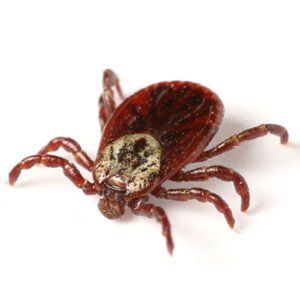Ticks are not insects, but arachnids. Like their close cousin, the spider, ticks have eight legs when they reach maturity. Ticks are born from eggs, advancing then to larva, nymph, and adult stages by molting. They survive on the blood of mammals, amphibians, birds and reptiles. North America is home to portions of two families of ticks, known more simply as hard ticks and soft ticks. Seven of the fourteen genera of hard ticks reside here, as well as all four genera of soft ticks.
Tick Control
Tick Control Services Provided in mid-Missouri

Many species of ticks are present in Missouri, but the most common are hard ticks called the lone star tick, the American dog tick, and the deer tick. Lone star ticks are known for their aggressive nature, often traveling long distances toward a potential host, as ticks crawl rather than fly or jump. Ticks are most active from April to July.
Each species is different, but all nymph and adult ticks have eight legs and an ovular body structure. Larva are the size of poppy seeds with eight legs. Once adults, they become the size of a sesame seed. Lone star tick females can be recognized by the white dot on their backs, while adult American dog ticks are dark brown in color.
Tick Borne Illnesses and Tick Diseases
Ticks are second only to mosquitoes in their ability to transmit human diseases, and they are the first in transmitting disease to wild and domestic animals. Any tick bite can be dangerous. They can pick up and spread pathogens like protozoa, bacteria and viruses. The most common diseases transmitted by ticks are Rocky Mountain spotted fever, Lyme disease, and ehrlichiosis.
Tick Prevention and Treatment for Tick Bites
If you regularly walk through uncut fields, brush, or other woodsy areas, make it a habit to check your skin and clothes for ticks. Light-colored clothing may help you more easily detect them. You can also reduce the risk of ticks around your home by keeping the lawn cut and hedges trimmed. Sunlight is your friend, so make sure you’re removing fallen leaves and brush from the ground. Also, keep your firewood neatly stacked to prevent an infestation. If you find yourself with a tick latched onto you, the best way to remove them is using tweezers. In order for the tick removal to be 100% effective, you need to ensure the head of the tick has been completely pulled out along with the rest of the body. Once removed, wash your hands thoroughly as well as the affected area and apply rubbing alcohol to sterilize. To ensure the tick does not return, place in a sealed container and freeze.
Tick Extermination for your yard by Steve’s Pest Control
Steve’s Pest Control will come and do an on-site tick control evaluation of your property. We’ll examine the size of your yard and the kind of vegetation you have growing there. If you have pets, we recommend flea and tick preventative treatment given on a regular basis. Based on the level of tick control you’re looking for, we’ll spray and treat the ground for ticks, and create a plan for continuous treatment.
FAQs Residential Ticks Pest Control: Ticks in the Home
Understanding Ticks vs. Insects for Effective Residential Tick Pest Control
Q. How do ticks, notorious for home infestations, differ from common insects?
A. Unlike insects, ticks are arachnids and, similar to spiders, mature into eight-legged pests.
How to Identifying Common Ticks in Missouri Homes
Q. What are the prevalent tick species in Missouri's residential areas?
A. The Lone Star tick, American dog tick, and deer tick are most commonly encountered in homes.
Tips for Recognizing Different Tick Species
Q. How can homeowners distinguish between various tick species?
A. For instance, female Lone Star ticks feature a distinctive white dot, while adult American dog ticks have a dark brown hue.
Understanding Tick Activity Peaks for Timely Home Pest Control
Q. When do ticks become a significant concern for homeowners?
A. Tick activity notably increases from April through July, demanding heightened vigilance.
Tick-Borne Diseases and Human Health Risks
Q. What health risks do ticks pose to families?
A. Ticks are vectors for serious illnesses like Lyme disease, Rocky Mountain spotted fever, and ehrlichiosis, necessitating prompt tick control measures.
Preventive Strategies for Residential Tick Infestations
Q. What can homeowners do to deter tick infestations?
A. Effective strategies include maintaining short lawns, trimming hedges, clearing leaf litter, and orderly stacking of firewood.
Safe and Effective Tick Removal Techniques
Q. How should one safely remove a tick to reduce the risk of infection?
A. Proper removal involves using tweezers to extract the entire tick, followed by disinfecting the area with rubbing alcohol.
Post-Removal Handling of Tick
Q. What is the recommended procedure for disposing of a removed tick?
A. Securely place the tick in a container and freeze it, a crucial step in tick control.
Steve's Pest Control: Specialized Tick Extermination and Inspection Services
Q. Does Steve's Pest Control offer tailored solutions for yard tick extermination?
A. Yes, they provide comprehensive evaluations and develop ongoing treatment plans tailored to your yard's specific needs.
Tick Control Considerations for Pet Owners
Q. What additional tick control measures should pet owners consider?
A. It’s crucial to regularly administer flea and tick preventatives to pets, an essential component of home tick control.
Contact Steve’s Pest Control for expert assistance in residential tick control today!

Steve’s Pest Control is a full-service pest control business run by a team of experts who are dedicated to taking care of your pest problems once and for all. We guarantee all of our pest control services with 100% customer satisfaction to ensure you are receiving the best.
Contact Information
© 2022 Steve's Pest Control. All Rights Reserved.
We will get back to you as soon as possible.
Please try again later.









